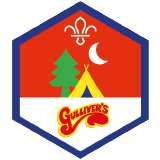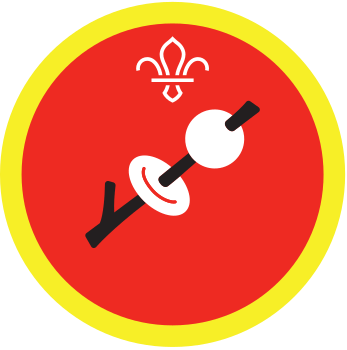Make and try different firelighters
You’ll need
- Kindling (for example, small sticks)
- Firewood
- Cardboard tubes
- Cotton wool balls
- Matches
- Shredded newspaper
- Petroleum jelly
- Tortilla chips
- Fire bucket
- Sand
Before you begin
- Use the safety checklist to help you plan and risk assess your activity. There's also more guidance to help you carry out your risk assessment, including examples. Don’t forget to make sure all young people and adults involved in the activity know how to take part safely.
- Find a safe space to collect firewood and build fires. Build a circle of large rocks to contain the fire(s). Have sand and/or a bucket of water on hand in case the fire gets too big.
- You’ll need plenty of adults for this activity – one to supervise each fire. You could invite parents and carers along to help.
Collect wood
- Everyone should split into small groups.
- Everyone should collect tinder, kindling, and wood. Natural tinder includes small twigs, wood shavings, and very dry leaves – anything that will burn very quickly for a short amount of time. Kindling is slightly bigger; it burns for slightly longer and includes thin sticks, bark, and pine cones. Wood includes sticks, branches, and logs.
- Once each group has collected enough tinder, kindling, and wood, they should sort it into four piles according to size.
As a guide, aim for a pile about the width of spaghetti, a pile about the width of a finger, a pile about the width of a wrist, and a pile wider than a wrist.
Make a firelighter
- The person leading the game should give each group the equipment to make a different type of firelighter.
-
- Stuffed tube: Stuff a cardboard toilet roll tube with cotton wool, wood shavings, or dried grass. Squeeze or fold the ends to stop the filling coming out.
- Jelly cotton wool: Smear petroleum jelly on cotton wool balls. Petroleum jelly isn’t flammable until the cotton wool heats it up, so it makes the firelighter last much longer.
- Stuffed egg box: Tear newspaper into thin strips and stuff it inside a cardboard egg box.
- Crisps: Use tortilla chips – they burn well because of the fat in them.
- Newspaper tubes: Roll newspaper into a tube shape, flatten it, and tie a knot (or fold it) in the middle.
- Each group should work with an adult to make a firelighter. They should aim to make a firelighter that will burn for long enough that the kindling has time to catch.
Build a fire
- Each group should put some of their tinder in the middle of their campfire.
- Each group should surround the tinder with some kindling. They should leave some spaces for their firelighter to reach the tinder.
- An adult should help each group light their firelighter. The adult should be in charge of lighting the firelighter, but they can supervise someone striking the match and lighting it safely.
- Each group should use their firelighter to light their tinder. They should blow lightly and slowly onto their tinder until the kindling also catches fire. They should use short and strong breaths to help the fire get going. If the firelighter doesn’t work, try again! You could make another or try a different idea.
- Each group should slowly add bigger and bigger pieces of kindling, and then pieces of wood, on top of their fire.
Once the wood is burning, everyone should enjoy the warmth and light from the fire they’ve made.
Reflection
This activity helped everyone learn the skills they need to get a campfire burning. What do people think would happen if they tried to start a fire by lighting a big log with a match? It’s very unlikely to catch – fires need to start small with a firelighter, dry tinder, and kindling. When collecting wood, why was it important to look for wood that’s dry and dead? Dry wood that snaps and breaks easily burn best. The person leading the reflection should remind everyone that when they collect firewood and other natural materials, it’s important to gather things that have already fallen from trees, rather than breaking off live twigs or branches.
This activity also needed everyone to work in teams. How did each team divide up the different tasks, for example, collecting the different sizes of wood, making the firelighters, and building up the campfire? How well did each group’s firelighter work compared to the others? What made some more or less successful? If each group were going to build another fire, what would they do differently? Maybe they’d want to think again about the firelighter they used, how they built their fire, or how they split the roles among their team.
Safety
All activities must be safely managed. You must complete a thorough risk assessment and take appropriate steps to reduce risk. Use the safety checklist to help you plan and risk assess your activity. Always get approval for the activity, and have suitable supervision and an InTouch process.
- Fires and stoves
Make sure anyone using fires and stoves is doing so safely. Check that the equipment and area are suitable and have plenty of ventilation. Follow the gas safety guidance. Have a safe way to extinguish the fire in an emergency.
- Rubbish and recycling
All items should be clean and suitable for this activity.
- Gardening and nature
Everyone must wash their hands after the activity has finished. Wear gloves if needed. Explain how to safely use equipment and set clear boundaries so everyone knows what’s allowed.
- Outdoor activities
You must have permission to use the location. Always check the weather forecast, and inform parents and carers of any change in venue.
Groups could talk about the shape of fire they’d like to build and then build their own.
Make it accessible
All Scout activities should be inclusive and accessible.
Once the fires are lit, you could cook a meal or a snack on them. This would meet another part of requirement one of the My Outdoors Challenge Award. It could also meet requirement three of the Camp Craft Activity Badge or requirement two of the My Adventure Challenge Award.


